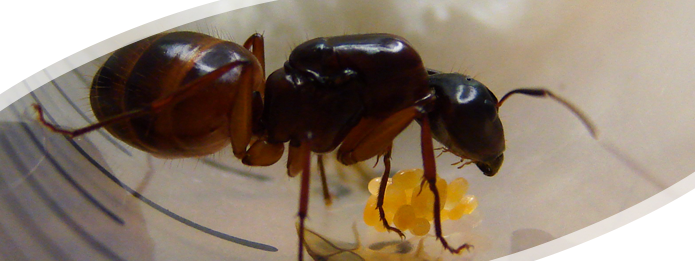
Do you have small, grub-like insects in your home? Explore the signs of carpenter ant larvae and what this means for your home. These small larvae are signs of a carpenter ant colony, which can be devastating for your home. Find out more about these tiny intruders and discover how you can enjoy premier carpenter ant pest control Niagara by Truly Nolen Canada.
Larval Stage
It all starts with a female carpenter ant ready to start a new colony. A batch of eggs takes up to 12 weeks to produce a number of adult ants. These slow-moving builders take between three and six years to fully establish a colony. Once established, it can be extremely damaging to your home and difficult to remove without professional tools and a pest control expert.
Eggs turn into larvae. Carpenter ant larvae look like grubs. They are white, don’t have legs and can’t fend for themselves. Adult carpenter ants must prepare a home for the grubs and bring them food. The queen cares for the larvae until she produces enough adult carpenter ants for the colony to thrive.
How Larvae Affect Your Home
A colony of carpenter ants digs a series of tunnels into wood. They love moist wood but will happily dig into dry framing as well. These ants don’t eat wood like termites but use it as building material. Just like termites, their nests can compromise the structure of your home.
Larvae are a sign of a growing colony. Depending on the stage of growth, removing larvae may stop the colony from growing or it may have little effect. Carpenter ants can build surprisingly large networks of tunnels throughout your home, so don’t assume that a single area with larvae is the entire nest.
Signs of Carpenter Ant Colonies
Carpenter ants are tidy intruders. Unlike termites, they create tidy tunnels and remove most or all of the wood debris, or frass, from their nest. This makes it more difficult to spot the signs of a colony in your home.
Look for small holes, tunnels and bits of debris around the exterior of your home. Carpenter ants love moist, rotten wood but will happily build in dry wood, fiberglass insulation and other materials. Hot tubs, attics, basements, and decks are common places to find carpenter ants, but they may also be inside furniture, cabinets, and other structures.
Look for flying ants around your home in the spring. These may be male carpenter ants ready to mate. This can be a sign that ants are attempting to start a colony or that an existing colony is spreading.
Colonies typically form into parent and satellite colonies. Only the parent colony will have the egg-laying queen, but larvae are commonly found in satellite colonies. If you find a small cluster of grub-like carpenter ant larvae, removing them may not prevent the colony from growing.
Remove and Prevent Ants With Truly Nolen
Removing carpenter ant larvae may not be enough. These tiny grub-like ants are typically raised in satellite colonies, so you may not be dealing with the source of an infestation. Don’t cover up the signs of carpenter ants without dealing with the source, but work with a pest control professional to find the root of the issue and deal with it in a safe, environmentally friendly way.
Request an inspection from Truly Nolen Canada today to determine the extent of carpenter ant presence in your home. Spotting carpenter ant larvae may mean that they are just settling into your home or you may have only found a satellite of a large nest. Work with local, qualified pest control experts to safely remove and prevent these wood-eating intruders.